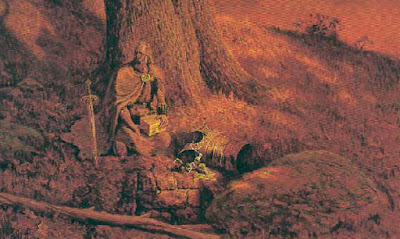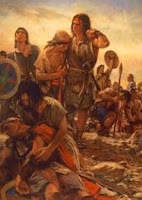Wherever Mormon was when he
finished his abridgement of the Large Plates of Nephi, those plates kept by
the kings and sometimes referred to by Nephi as “mine other plates,” is not
told us. Certainly, it was not in the comfort of his “office” as we see in the
famous drawing I love to use:
It was probably more accurate to
think of him on a battlefield somewhere, hiding out in a cave, or recovering
from his wounds. But wherever it was, it seems that his mental framework might
be important to understand his final writings.
Somewhere in those last days,
either just after, or more likely just before that final battle at Cumorah,
Mormon finished abridging the record. As he states: “And it came to pass that when we had gathered in all our
people in one to the land of Cumorah, behold I, Mormon, began to be old; and
knowing it to be the last struggle of my people, and having been commanded of
the Lord that I should not suffer the records which had been handed down by our
fathers, which were sacred, to fall into the hands of the Lamanites, (for the
Lamanites would destroy them) therefore I made this record out of the plates of
Nephi, and hid up in the hill Cumorah all the records which had been entrusted
to me by the hand of the Lord, save it were these few plates which I gave unto
my son Moroni” (Mormon 6:7).
He must have felt
pretty good about completing one of his life-long tasks, i.e., abridging the
record of all the prophets and writers, from Benjamin down to Ammaron, who had
been constrained by the Holy Ghost to hide up the records which had been handed
down from generation to generation in the year 320 A.D. (4 Nephi 1:48). These
are the same records that Mormon mentions in his own works (Mormon 1:2), and
that he did take out of hiding before the final battle.
Mormon retrieves the records that Ammaron hid up in the hill Shim years earlier
Whether this had been an ongoing
work, started years earlier, or something that he accomplished in a short time
just before Cumorah and the final battle is not exactly clear; however, it
would seem from the record that he took them out of hiding. This probably
occurred when the “revenge-minded” Nephites decided to attack the Lamanites in
the latter’s own territory and Mormon declined to lead them. During those final
years, it is most likely Mormon abridged the record as he watched the final
decline of his army from a distance.
At one of these points later in
life, Mormon takes the records out of hiding of which Ammaron had told him
years earlier. Those records were evidently the Large Plates of Nephi,
including the Plates of Lehi and the overall Record of Nephi, which must have
been the 116 pages earlier abridged and ended up being translated by Joseph
Smith and ultimately lost by Martin Harris. After accomplishing that part of
his assignment, Mormon turned to the record of the kings that had been in the
hands of Benjamin forward to Ammaron. At what point he actually wrote his own
book, that is the final book he named the Book of Mormon, is not known, but it
would be assumed it was awaiting that final battle at Cumorah, or just before
his writing to King Laman as to fighting that final battle at Cumorah, or
possibly while waiting at Cumorah for the Lamanite armies to arrive.
It is also likely that the final
two chapters, Mormon 6 and 7, were written by him on, or near, the hill Cumorah
after his being wounded and before dying, and during the time or after that he
looked down upon the dead of 230,000 of his fighting men, and their wives and
children.
Some will say it really doesn’t
matter, and perhaps it does not, however, I am more inclined to appreciate the
mental and physical state of the magnificent men who wrote that record, whose
life blood was spilt in defense of their nation or in the building up of that
nation, the Church, and trying to establish peace in the land.
As an example, consider Mormon
as he wrote his sixth chapter. If it was after that battle and before his
death, as some claim, it picks up with his narrative about “marching forth
before the Lamanites” (Mormon 6:1). He starts with having written a letter to
the king of the Lamanites that they could have their final battle at the hill
Cumorah (Mormon 6:2), and that they obtained an agreement, and continued on to
Cumorah where Mormon talks about pitching their tents around the hill Cumorah
(Mormon 6:4). He tells us that this was in 384 A.D., and that the Nephites had
spent some time gathering “all the remainder of our peole unto the land of
Cumorah” (Mormon 6:5).
If this was after that battle,
then during the time while gathering in their people and marching to Cumorah,
Mormon most likely finished his abridgement and the writing of the first five
chapters of his own book. It is possible that during that time or just before,
while fighting running battles with the Lamanites, Mormon wrote to his son,
Moroni, in what appears in his book as chapters 8 and 9, which Moroni included
in the record after his father’s death.
So for this brief moment in
time, which could have been weeks, maybe months, even a year or two, Mormon has
time to reflect on his life, finish his abridgement and ready himself for that
final battle that, while he hoped Cumorah might provide some advantage for them
over the Lamanites (Mormon 6:4), deep in his heart he knew it would be the
final battle of his people (Mormon 6:6).
How close he was to finishing
his abridgement we are not told, but also fearful of failing in his assignment
to make sure the sacred records did not fall into the hands of the Lamanites,
Mormon hurries to complete his abridgement and hide up the records in the hill
before that final battle.
Mormon, after the battle at Cumorah, looking out over the battlefield at the dead of his 230,000 troops and their wives and children. What a sad moment for him, which shows up in his descriptive writing
Assuming he completed this task
before the final battle, Mormon sets aside the records and prepares for battle,
apparently knowing he would not survive it. Yet, after that day-long battle,
and being wounded severely, he does survive through the night and into the
next day or two. From the top of the hill, where his son and the other few
survivors must have carried him during the night from the battlefield where he
had been wounded (Mormon 6:10), he looks down upon the death and carnage of
that final battle where he records his view as he wrote of his memory of the
battle—and having been defeated in that first wave, may well have relied upon
Moroni or the other’s account of what happened. His sorrow can be felt as one
reads his lament, beginning with the terrible anxiety of his people awaiting
the overwhelming army of the Lamanites approaching (Mormon 6:7).
When one stands in battle as an
overwhelming foe approaches, their life passes before their eyes in one way or
another—certainly, for these Nephites who had been unwilling to repent of their
sins and call upon the Lord in those last years, no doubt were ravaged with
their awful guilt for they were “filled with terror because of the greatness of
the (Lamanite) numbers” (Mormon 6:8). And as any leader of people knows, Mormon
felt the overwhelming concern for his people who stood now unprotected by the
Lord, awaiting their “awful fear of death which fills the breasts of the
wicked” (Mormon 6:7).
Then Mormon was hewn down and
the waves of Lamanites passed by him, leaving him alive but probably severely
wounded. At some point Mormon would have regained consciousness, probably
during the night after being carried to the top of the hill for safety by those
23 other survivors, including his son, Moroni (Mormon 6:11). What a horrible feeling must have passed through him as he learned of the final moments of the battle and what happened to all his people.
(See the next post, “The Words
of Mormon – Part II,” for this prophet’s last acts and final writing and
disbursement of the plates)
Subscribe to:
Post Comments (Atom)









No comments:
Post a Comment